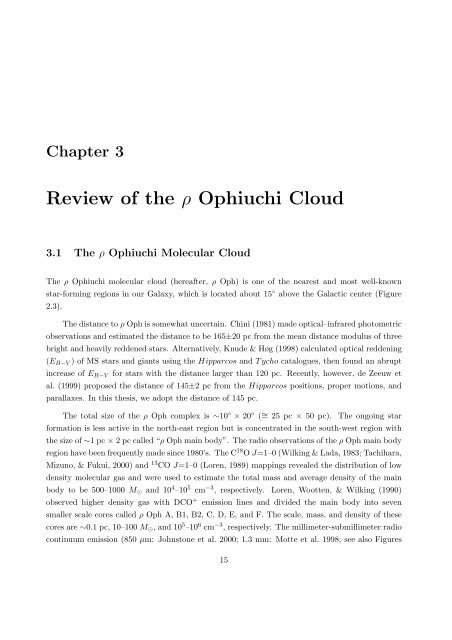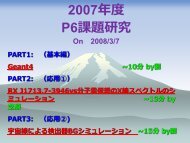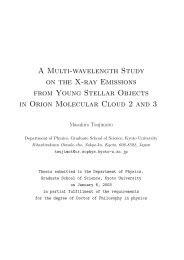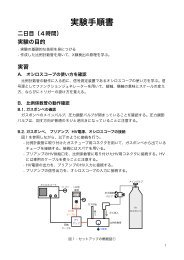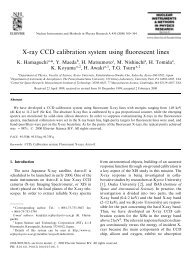X-ray Study of Low-mass Young Stellar Objects in the ρ Ophiuchi ...
X-ray Study of Low-mass Young Stellar Objects in the ρ Ophiuchi ...
X-ray Study of Low-mass Young Stellar Objects in the ρ Ophiuchi ...
Create successful ePaper yourself
Turn your PDF publications into a flip-book with our unique Google optimized e-Paper software.
Chapter 3Review <strong>of</strong> <strong>the</strong> <strong>ρ</strong> <strong>Ophiuchi</strong> Cloud3.1 The <strong>ρ</strong> <strong>Ophiuchi</strong> Molecular CloudThe <strong>ρ</strong> <strong>Ophiuchi</strong> molecular cloud (hereafter, <strong>ρ</strong> Oph) is one <strong>of</strong> <strong>the</strong> nearest and most well-knownstar-form<strong>in</strong>g regions <strong>in</strong> our Galaxy, which is located about 15 ◦ above <strong>the</strong> Galactic center (Figure2.3).The distance to <strong>ρ</strong> Oph is somewhat uncerta<strong>in</strong>. Ch<strong>in</strong>i (1981) made optical–<strong>in</strong>frared photometricobservations and estimated <strong>the</strong> distance to be 165±20 pc from <strong>the</strong> mean distance modulus <strong>of</strong> threebright and heavily reddened stars. Alternatively, Knude & Høg (1998) calculated optical redden<strong>in</strong>g(E B−V ) <strong>of</strong> MS stars and giants us<strong>in</strong>g <strong>the</strong> Hipparcos and T ycho catalogues, <strong>the</strong>n found an abrupt<strong>in</strong>crease <strong>of</strong> E B−V for stars with <strong>the</strong> distance larger than 120 pc. Recently, however, de Zeeuw etal. (1999) proposed <strong>the</strong> distance <strong>of</strong> 145±2 pc from <strong>the</strong> Hipparcos positions, proper motions, andparallaxes. In this <strong>the</strong>sis, we adopt <strong>the</strong> distance <strong>of</strong> 145 pc.The total size <strong>of</strong> <strong>the</strong> <strong>ρ</strong> Oph complex is ∼10 ◦ × 20 ◦ ( ∼ = 25 pc × 50 pc). The ongo<strong>in</strong>g starformation is less active <strong>in</strong> <strong>the</strong> north-east region but is concentrated <strong>in</strong> <strong>the</strong> south-west region with<strong>the</strong> size <strong>of</strong> ∼1 pc × 2 pc called “<strong>ρ</strong> Oph ma<strong>in</strong> body”. The radio observations <strong>of</strong> <strong>the</strong> <strong>ρ</strong> Oph ma<strong>in</strong> bodyregion have been frequently made s<strong>in</strong>ce 1980’s. The C 18 O J=1–0 (Wilk<strong>in</strong>g & Lada, 1983; Tachihara,Mizuno, & Fukui, 2000) and 13 CO J=1–0 (Loren, 1989) mapp<strong>in</strong>gs revealed <strong>the</strong> distribution <strong>of</strong> lowdensity molecular gas and were used to estimate <strong>the</strong> total <strong>mass</strong> and average density <strong>of</strong> <strong>the</strong> ma<strong>in</strong>body to be 500–1000 M ⊙ and 10 4 –10 5 cm −3 , respectively. Loren, Wootten, & Wilk<strong>in</strong>g (1990)observed higher density gas with DCO + emission l<strong>in</strong>es and divided <strong>the</strong> ma<strong>in</strong> body <strong>in</strong>to sevensmaller scale cores called <strong>ρ</strong> Oph A, B1, B2, C, D, E, and F. The scale, <strong>mass</strong>, and density <strong>of</strong> <strong>the</strong>secores are ∼0.1 pc, 10–100 M ⊙ , and 10 5 –10 6 cm −3 , respectively. The millimeter-submillimeter radiocont<strong>in</strong>uum emission (850 µm: Johnstone et al. 2000; 1.3 mm: Motte et al. 1998; see also Figures15


